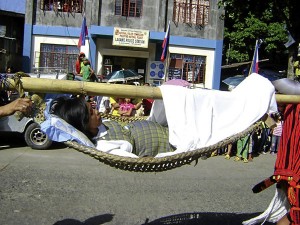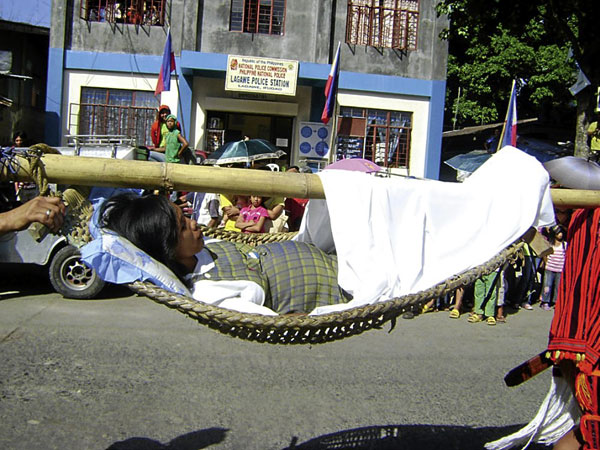
IFUGAO – It took more than an hour to navigate the unpaved roads that lead to Barangay (village) Boliwong, just two kilometers away from the Ifugao capital of Lagawe. It was a sunny afternoon, but parts of the road were slushy and muddy, softened by the light rains of the previous day. Our tires sank into the ground, slowing us even more.
It is in Barangay Boliwong where Auri, a 21-year-old mother, lives with her baby girl born just days earlier. From her home, Auri has an idyllic view of vast rice fields that lead up to mountain areas even farther away than Boliwong.
“I gave birth in the center,” explained Auri, referring to the Birthing Health Center (BHC) opened in Boliwong two years ago.
Without the center, Auri would have had to travel through the unpaved roads for more than an hour to reach the nearest hospital in Lagawe. Or like most Ifugao women, she would have given birth at home.
Elsa Pagal, the midwife in the Boliwong BHC, delivered Auri’s baby.
The BHC, with its small cots and modest equipment, services not only the more than 1,200 residents of Boliwong, but those of other nearby barangays as well.
“More and more women are giving birth at the BHC,” Pagal said, because the women now get better information about the benefits of giving birth in a facility rather than at home.
“Women here used to think that giving birth in the hospital was out of the question because of the distance and the expense. But now, there is the ayod,” Pagal explained.
“Ayod” is the Ifugao word for an improvised hammock made from a blanket tied to wooden poles. The ayod has long been a main fixture in Ifugao life as a simple and effective way of transporting the sick through rough mountainous terrain to get medical attention.
The ayod is carried by male relatives accompanied by two other relatives or neighbors who carry the food and water provisions. They also act as relievers when the two carriers need to rest.
For the Ifugaos who live in remote villages inaccessible to vehicles, the ayod is the only means of transport. It has often been referred to as “ambulance on feet” or “ambulansyang naka-paa.”
Now, the ayod has come to mean more than just the hammock. It has, under Provincial Executive Order 22, come to mean a community working together to protect women’s health.
The order established the Ayod Community Health Teams (ACHT) tasked to monitor and track the health of pregnant women in the community. The teams become part of the woman’s birth plan and are on call for emergencies.
“We keep track of the pregnant women and remind them about their monthly pre-natal exams through text or through door to door visits,” said Albert Dangpahon, the Barangay Captain of Boliwong.
Under E.O. 22, barangay captains like Dangpahon are part of the ACHT, whose other members include the rural midwife, the barangay health workers, the traditional birth attendant and nutritionists.
Across the 175 villages in Ifugao, there are now 185 community health teams and an estimated 2,865 members. There are two to four ACHTs per barangay depending on its population, with eight to 12 members in each team.
The teams are slowly but surely lowering maternal death.
According to the 2006 figures released by the National Statistical Coordination Board, Ifugao has a maternal mortality ratio (MMR) of 260 per 100,000 live births, which is above the national average of 162/100,000.
The mountainous terrain makes it difficult and expensive to access health care and many women prefer to give birth at home. The National Demographic Health Survey of 2008 shows that 70 percent of births in Philippine rural areas are home births.
The introduction of the ACHTdid not change things overnight, however.
“Mothers were still hesitant to use the facilities, thinking that the BHCs had no equipment and no staff,” explained Dr. Mary Josephine Dulawan, Ifugao Provincial Health Officer. “They thought they would be better off delivering at home under the care of a manghihilot (skilled birth attendant) who can cook for them and clean up after them. At home, their husbands would also be around.”
Added Dulawan: “Ifugao is the first province in the country to craft a reproductive health ordinance in support of the Millennium Development Goal of maternal health.”
The Millennium Development Goals (MDG) is a worldwide project started in 2000 to reduce the various dimensions of poverty such as maternal death. In the Philippines, the goal is to reduce maternal death to 55 per 100,000 by 2015. Currently, at the rate of 162 deaths per 100,000 live births, health experts have predicted that the Philippines will not meet the MDG maternal health goal.
The ACHTs are trying to remedy that. The teams are continuously promoting the importance of facility deliveries through community general assemblies where women speak about their birthing experience in a clinic.
Slowly, the number of deliveries at BHCs started rising. According to the Japan International Cooperation Agency (JICA), which supported the ACHT project, the number of deliveries at BHCs has significantly increased from 8 in 2007 to 108 in 2008, to almost 120 as of October 2009.
There has also been a marked reduction in MMR – down to 133 for every 100,000 live births (from 260 in 2006 in Ifugao province). In some villages, the results are even more impressive. Dulawan reported that in 2010, there was zero maternal deaths in the neighboring villages of Boliwong, Alista and Aguinaldo.
“Solid community efforts have made facility-based deliveries the norm, rather than the exception. And we are seeing the results of that,” said Nobuko Yamagishi, JICA health program coordinator.
It takes a village to raise a child, but it also takes solid community efforts – helped along by a hammock – to make sure that the mother can safely deliver that child into the world. Women’s Feature Service














































